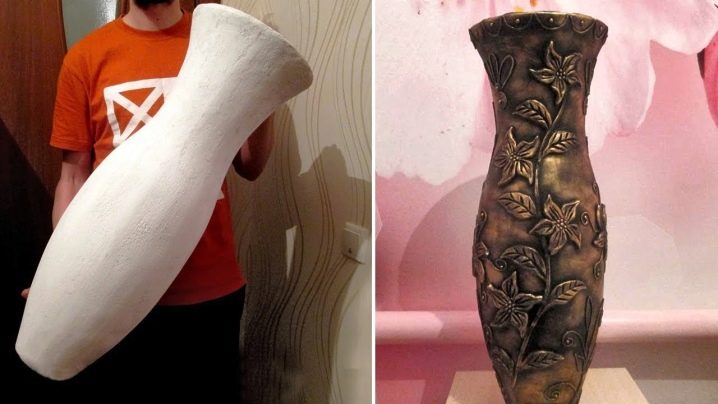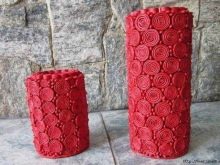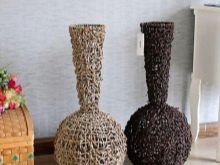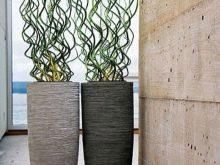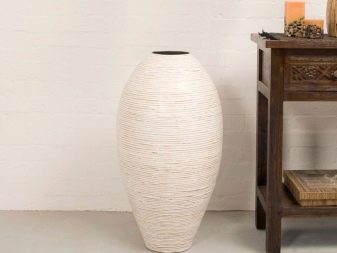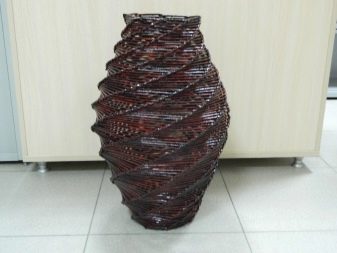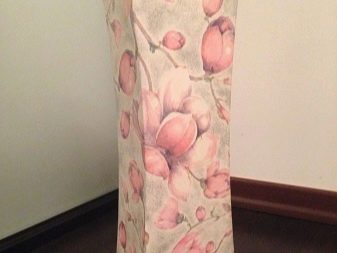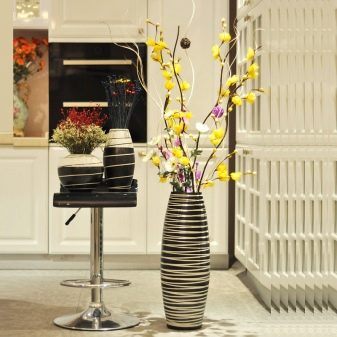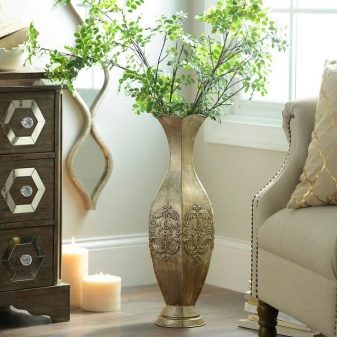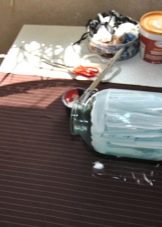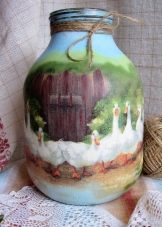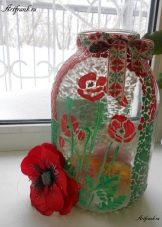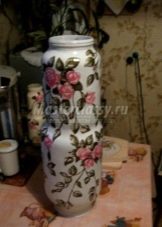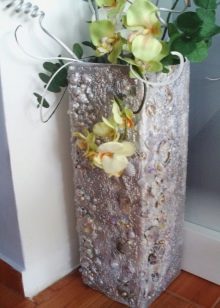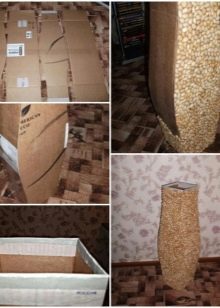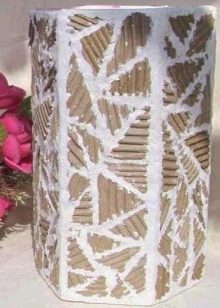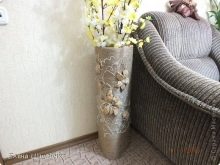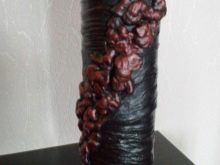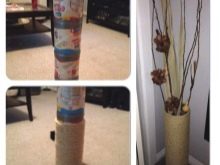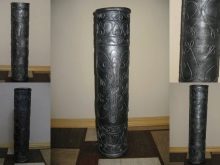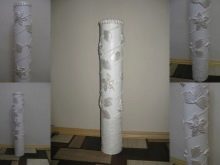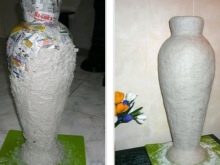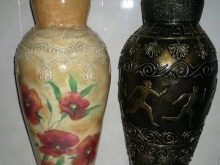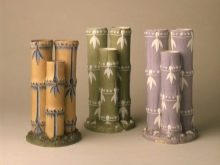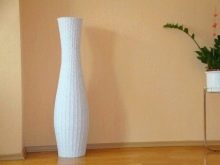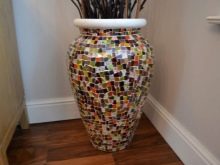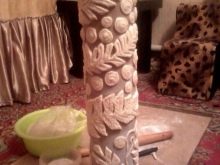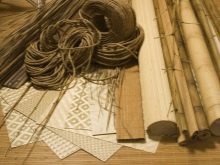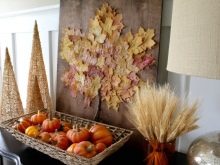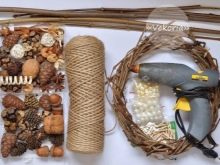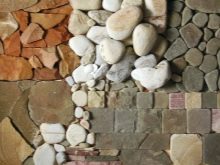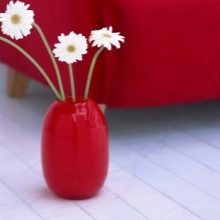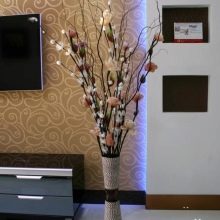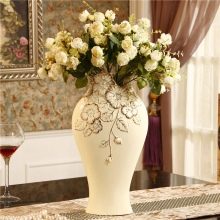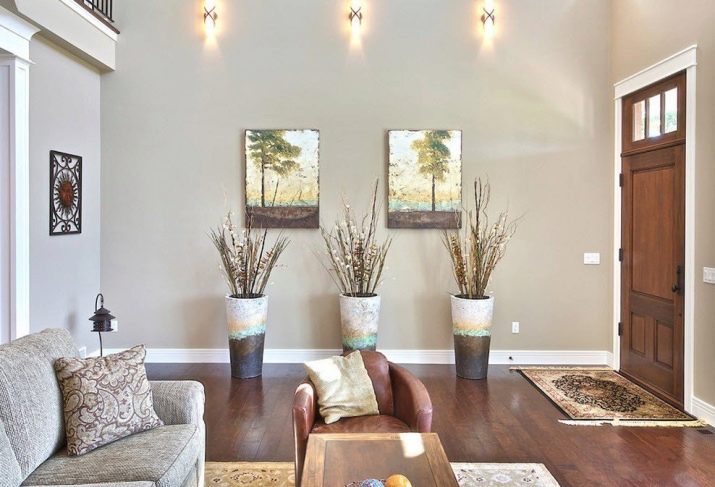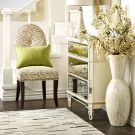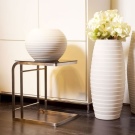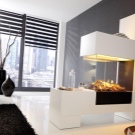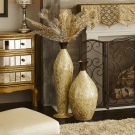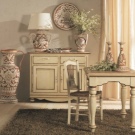How to make a floor vase with your own hands?
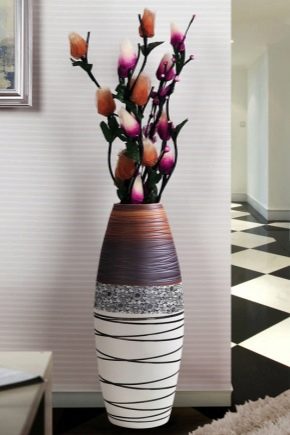
Today, rarely any interior, like the landscape, dispenses with expressive and spectacular accessories. One of them can rightly be called a floor vase. In order for it to look stylish and harmonious in the space provided for it, it is not at all necessary to buy the finished product. He is quite capable of doing independently, which will be discussed in this article.
Choice of size and shape
Floor vases can be different: high, medium height and width, large and moderate size.The parameters of the floor vase depend on a number of factors. One of the key is the design of the surrounding space. For example, the dimensions may depend on the footage of a particular room, because the smaller it is, the smaller the vase itself should be. If you do not take into account this fact, the accessory may look too bulky in the interior, thereby disturbing the visual balance.
The height of the product can vary in the range from 40 to 90 cm. It is selected, paying attention to the height of the walls and the spaciousness of the room, since an accessory too high can visually make the height of the walls smaller, which is unacceptable. The width is selected on the basis of their own preferences, as well as available for the manufacture of the form. In addition, it may depend on the chosen style, which should coincide with the interior design.
The shape of a floor vase can be conditionally roundish, square, triangular. Each type has its own nuances, for example, the rounded shape is considered the most harmonious for infusion into different stylistic directions of design. You can make it using bottles or even three- and five-liter glass jars. The papier-mâché technique is also suitable for this.
The square floor vase is good for modern interior compositions. The basic form for its manufacture can be a regular box made of cardboard. Variants of a triangular shape are somewhat more difficult to do, since it is less common to select such shapes. Products of this type are more often made of improvised raw materials or various constituent elements (for example, newspaper tubes).
Manufacturing methods
You can make a floor vase with your own hands out of waste material, improvised means and even ordinary dishes. Masters make such accessories not only from three-liter cans and papier-mâché, but also from plumbing pipes, plaster, twine, linoleum. To make it stand out against the background of the interior, as well as harmoniously fit into it, it is better for a beginner to choose to create a version of a symmetrical shape of a rounded type. It is important to consider: the product looks better on the general background, if its shade does not match the color of the floor covering, furniture and wall cladding.
From the three-liter cans
This work is notable for the fact that without drawing skills, it allows you to get a product with an imitation of artistic painting.In addition to banks, for the manufacture of vases need wipes for decoupage, acrylic paints, brushes, twine and special glue, as well as the necessary decorating accessories (selected at will). A method of making such a floor vase consists of several successive steps:
- the surface of the can is degreased and coated with white acrylic paint;
- after it dries, twine (or tape) is wound on the neck;
- prepare the elements of decor (cut out of napkins);
- they are glued, straightening with a brush, creating a pattern, ornament or other composition;
- after drying, a clear acrylic lacquer is applied on top.
The decor for gold and bronze looks beautiful, and for such a creation of a vase it is enough to use a contour gel, drawing them a simple drawing. If you cover such a product with dark paint from above and spray it with gold in some places with a sponge, such a vase will look expensive.
Out of the box with a beautiful shape
Such vases look quite unusual in the interior, they are very effects, but they are suitable mainly for modern style, as well as landscape compositions. For its manufacture need a box (form), gypsum (cement), a container for the formation of internal space and food film to make it easier to remove the vase from the base:
- gypsum is mixed with water until homogeneous, achieving the consistency of thick cream;
- it is poured into the box with a small layer;
- inside put a smaller capacity, setting it in the center;
- add the mixture to the desired level;
- when the composition is completely dry, the vase is removed from the mold;
- treated with fine sandpaper and decorated.
If you want to give a picture of such a product, you can do this by using spray paint and lace braid. The band tightly attached to the base, on top of her spray paint. If you want more chic, you can add a little silver or gold, causing it with a sponge.
From sanitary pipe
For such a product, sometimes not only familiar materials are used, but even nylon stockings and knitted fabrics. The design of the future vase depends on the type of the product itself, its material and shape. Options with kinks are more suitable for decorating the landscape and cottages. Products with a straight cylindrical shape are relevant for urban apartments.
The best material suitable for work can be called plastic and metal plumbing pipes. They can be pasted over with a different decor (including even barley), or you can add a relief pattern. For example, you can make a plastic trio of pipes of different height, cutting off their top at an angle. The bottom of such vases make cardboard, although if desired, and the appropriate skills to the metal and can be welded.
You can wear a nylon stocking on each tube to form pleats. On top of the surface is impregnated with glue and wait until it dries completely. After the base is created, proceed to decorating the vases, covering each of them with special paint in cans.
The color is chosen based on the features of the color solutions of the specific room in which the accessory will stand. It remains to add a little gilding or even glitter - and the unique decor is ready.
From paper pipe from linoleum
Such a product can be used for dry branches. To create it is simple: you need the pipe itself (you can buy it at the hardware store), twine or rope thread, some cardboard, a heat gun with glue and a saw to cut the pipe. The manufacturing method is as follows:
- the necessary quantity is cut off from the pipe, having previously determined the height of the vase;
- they take a thick cardboard and, putting a pipe on it, circle it, and then cut out the bottom;
- sticking the bottom to the future vase, they decorate it using rope or twine;
- thread wrapped vase from top to bottom, sticking to the base with hot glue (you can use other adhesives);
- tightly wrapping the product to the top, cut the thread;
- for stability, they put some paper or small stones inside.
From thick cardboard and cardboard tube
To create a Greek vase, you will need old newspapers, a cardboard tube and a few large boxes that can be taken in the store. They will have to cut out the base of the vase, so it is advisable to take boxes of approximately the same size (it does not make sense to glue them). This option of making a floor vase is more laborious, but the look of the finished product will please not only the owners of the house: such a product will be quite a bright and memorable accent of the interior. Create such a masterpiece on the following technology:
- correlate the height of the pipe, the desired height and size of the available boxes (everything should be the same);
- cut out the pattern of the vase, encircle the blank on it, cut out and fold in half;
- when there are enough of them, they are glued over a cardboard tube (you get a kind of accordion);
- after tearing the newspapers into pieces, they are impregnated with PVA glue and create the base of the vase, pasting it from top to bottom in several layers, trying to keep the shape smooth;
- after the newspaper you can stick several layers of toilet paper;
- when it dries, the surface is covered with dark paint;
- contour gel or special contour paint draw an ornament;
- You can cover the vase with another thin layer of paint, and then mark the relief pattern with bronze or gold paint.
To make a vase look expensive, you need to do it as carefully as possible, paying attention to the neck and bottom. When covering it is important to paint them too, the lines of the pattern should be smooth, and when ornamented, they should be identical.
Decoration of the finished product
Decoration of the finished accessory will require knowledge of the basic skills of stylistics, without which it is difficult to make it appropriate in a particular interior. Today, fashion trends are aimed at a combination of conciseness and functionality. The decor should be minimal, it is important that, with seeming simplicity, the product looks status, effectively and professionally, as if it were purchased in an expensive store. Therefore, to approach the issue of decoration should be especially careful.
Depending on the type of material used and the technique of making a floor vase, you can use it to decorate it:
- mosaic, including home-made from multicolored tiles and mirrors;
- flat buttons of various sizes and shapes;
- coins;
- coarse salt;
- grain, seeds of sunflower and pumpkin;
- dry branches of different lengths and curvatures;
- branch cuts;
- twine;
- tree bark;
- newspaper rolls;
- stationery gum;
- bracelets of rubber beads;
- decorative fabric;
- burlap;
- kraft paper;
- textile with embossed texture;
- rope thread;
- acrylic paints, including in the form of a spray;
- contour and stained paints;
- seashells of various shapes and sizes;
- napkins for decoupage;
- acrylic glue;
- newspapers and magazines;
- cardboard and white paper;
- bamboo twigs and wheat ears;
- self-adhesive decor.
In the skillful hands of a stylist, even an ordinary glass jar or bottle can become a work of art. And on its decor, as a rule, does not take much time. Someone simply puts a deep container inside the jar, and fills the entire internal space with small candies or even various croup, alternating it in layers.A more interesting solution is to put on a glass fabric knitted with openwork or bundles (or even a cut sleeve from a knitted jacket). Due to such “clothes”, a product can bring a certain amount of home comfort into the interior.
Variants of use in the interior
Floor vase can be put in different rooms, as well as in different places. For example:
- it harmoniously looks down the side of the stairs;
- no less expressive is her presence in the living room near a set of upholstered furniture, where everyone will pay attention to it;
- You can put an original accessory near a small stand and a chair;
- the proximity of the floor vase with a bedside or other compact table is appropriate;
- a beautiful vase, which is part of the composition decor, can stand near the dresser, on which accessories of smaller sizes, but of a uniform design are located;
- you can put not one, but three vases, placing them near the wall with paintings;
- You can decorate with an extraordinary vase or even two space near the panoramic window;
- You can fill the access point with a fireplace or window.
There are many options for using a floor vase in the interior.The specific place, as a rule, is prompted by the layout of the room itself. This is a place in a niche, a part of a ledge, a place on the side of the closet, in the corner of the home library, a video zone, and even a hallway.
The main thing is that it stands out, you need to choose the right color before starting work. For example, a white vase needs contrast and is lost against the background of white wall cladding.
How to make a floor vase with your own hands from scratch, see the following video.
